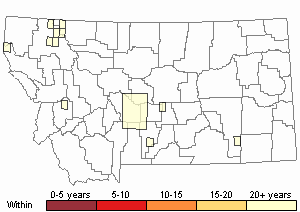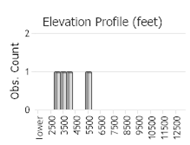View in other NatureServe Network Field Guides
NatureServe
Montana
Utah
Wyoming
Idaho
Wisconsin
British Columbia
South Carolina
Yukon
California
New York
Jade Tufa Moss - Gymnostomum aeruginosum
General Description
Plants: Acrocarpous, growing in clumps or cushions of erect shoots, seldom in large, crowded patches, deep to pale green above, brown below (FNA 2007). Stems 2-20 mm in height, seldom to 80 mm (Lawton 1971), frequently forking; rhizoids few; axillary hairs with the first 1 or 2 cells typically somewhat brown (FNA 2007).
Leaves: Pressed next to the stem when dry, spreading a little to more than 45 degrees, strongly bent back and downward above, wide and lance-shaped or tending to oblong, leaf tip curved and obtuse or nearly so or with a sudden short point, 0.5-2 mm in length (FNA 2007); margins flat (Lawton 1971); costa ending at or shortly before the leaf tip (FNA 2007).
Leaf Cells: Upper laminal cells isodiametric (FNA 2007), heavily papillose (Lawton 1971); proximal laminal cells short and quadrangular; leaf margins minutely scalloped from papillae (Crum & Anderson et al., 1981); costa in X-section with ventral superficial cells (FNA 2007), the ventral stereid band faint (Crum and Anderson et al., 1981) and absent distally (Flowers 1973), 1 series of 2-4 guide cells, a dorsal stereid band, and a dorsal superficial epidermis scarcely different from the adjacent stereids (FNA 2007).
Phenology
Fruit ripens summer to autumn (FNA 2007).
Diagnostic Characteristics
The related Hymenostylium recurvirostrum, also attracted to water and limestone, has leaves that taper more than the often oblong leaves of G. aeruginosum (FNA 2007) and leaf edges that have one side curved back and downward when moist rather than both sides flat (Crum & Anderson et al., 1981). It also has ventral superficial cells of the costa that are long, slender, and without papillae; those of G. aeruginosum are square and papillose, only somewhat long in very compact leaves (FNA 2007).
Range Comments
North American Range
Canada: NT, BC and AB, MB to NL and NS; USA: AK and most continental states (unknown from SC to FL and in a few other scattered states); Mexico (FNA 2007). Known in Montana from Carter, Cascade, Flathead, Glacier, Golden Valley, Lincoln, Missoula, and Sweet Grass Counties (Elliott & Pipp, 2016).
Observations in Montana Natural Heritage Program Database
Number of Observations: 17
(Click on the following maps and charts to see full sized version)
Map Help and Descriptions
Relative Density

Recency



 (Observations spanning multiple months or years are excluded from time charts)
(Observations spanning multiple months or years are excluded from time charts)
Habitat
Moist, calcareous stone, often residing near waterfalls and wet canyon walls. Ranging in elevation from 0 to 9840 feet (FNA 2007). Known in Montana from Carter, Cascade, Flathead, Glacier, Golden Valley, Lincoln, Missoula, and Sweet Grass Counties (Elliott & Pipp, 2016).
Reproductive Characteristics
Dioicous and typically with numerous capsules (Flowers 1973). Perigonia bud-like, lateral, or situated at the top of the stem. Perichaetia solitary at the end of a long axis, with upper laminal cells heavily papillose and square, elongating toward the base. Seta spiraled clockwise (FNA 2007), 3-4 mm in height (Lawton 1971). Capsule glossy light brown (Crum & Anderson et al., 1981) with a broad opening (FNA 2007); theca 0.5-0.8 mm in length (Lawton 1971); operculum beaked, with straight cells; peristome teeth lacking. Calyptra draping hood-like (FNA 2007).
Stewardship Responsibility
References
- Literature Cited AboveLegend:
 View Online Publication
View Online Publication Crum, H.A. and L.E. Anderson. 1981. Mosses of Eastern North America. 2 volumes. Columbia University Press, New York. 1328 pp.
Crum, H.A. and L.E. Anderson. 1981. Mosses of Eastern North America. 2 volumes. Columbia University Press, New York. 1328 pp. Elliott, J.C. and A.K. Pipp. 2018. A Checklist of Montana Mosses (1880-2018). Updated 3 January, 2020. Montana Natural Heritage Program, Helena, Montana. 73 pp.
Elliott, J.C. and A.K. Pipp. 2018. A Checklist of Montana Mosses (1880-2018). Updated 3 January, 2020. Montana Natural Heritage Program, Helena, Montana. 73 pp. Flora of North America Editorial Committee, eds. 2007. Flora of North America North of Mexico. Volume 27. Bryophytes: Mosses, Part 1. Oxford University Press, Inc., NY. xxi + 713 pp.
Flora of North America Editorial Committee, eds. 2007. Flora of North America North of Mexico. Volume 27. Bryophytes: Mosses, Part 1. Oxford University Press, Inc., NY. xxi + 713 pp. Flowers, S. 1973. Mosses: Utah and the West. Brigham Young University, Provo, Utah. 567 p.
Flowers, S. 1973. Mosses: Utah and the West. Brigham Young University, Provo, Utah. 567 p. Lawton, E. 1971. Moss Flora of the Pacific Northwest. Hattori Botanical Laboratory. Japan: Yamabuki-cho, Shinjuku-ku, Tokyo. 362 pages plus appendices.
Lawton, E. 1971. Moss Flora of the Pacific Northwest. Hattori Botanical Laboratory. Japan: Yamabuki-cho, Shinjuku-ku, Tokyo. 362 pages plus appendices.
- Additional ReferencesLegend:
 View Online Publication
View Online Publication
Do you know of a citation we're missing? Elliot, J. C. 1993. Second checklist of Montana mosses. Unpublished report. U.S. Forest Service, Region 1. Missoula, MT. 45 pp.
Elliot, J. C. 1993. Second checklist of Montana mosses. Unpublished report. U.S. Forest Service, Region 1. Missoula, MT. 45 pp. Lawton, E. 1971. Keys for the Identification of the Mosses on the Pacific Northwest. Reprinted from 'Moss Flora of the Pacific Northwest'. Published as Supplement No. 2 of the Journal of the Hattori Botanical Laboratory. Nichinan, Miyazaki, Japan. 66 pp.
Lawton, E. 1971. Keys for the Identification of the Mosses on the Pacific Northwest. Reprinted from 'Moss Flora of the Pacific Northwest'. Published as Supplement No. 2 of the Journal of the Hattori Botanical Laboratory. Nichinan, Miyazaki, Japan. 66 pp. Malcolm, B., N. Malcolm, J. Shevock, and D. Norris. 2009. California Mosses. Nelson, New Zealand: Micro-Optics Press. 430 pp.
Malcolm, B., N. Malcolm, J. Shevock, and D. Norris. 2009. California Mosses. Nelson, New Zealand: Micro-Optics Press. 430 pp. Smith, A.J.E. 1980. The Moss Flora of Britain and Ireland. Cambridge University Press, Cambridge. 705 pp.
Smith, A.J.E. 1980. The Moss Flora of Britain and Ireland. Cambridge University Press, Cambridge. 705 pp.
- Web Search Engines for Articles on "Jade Tufa Moss"





